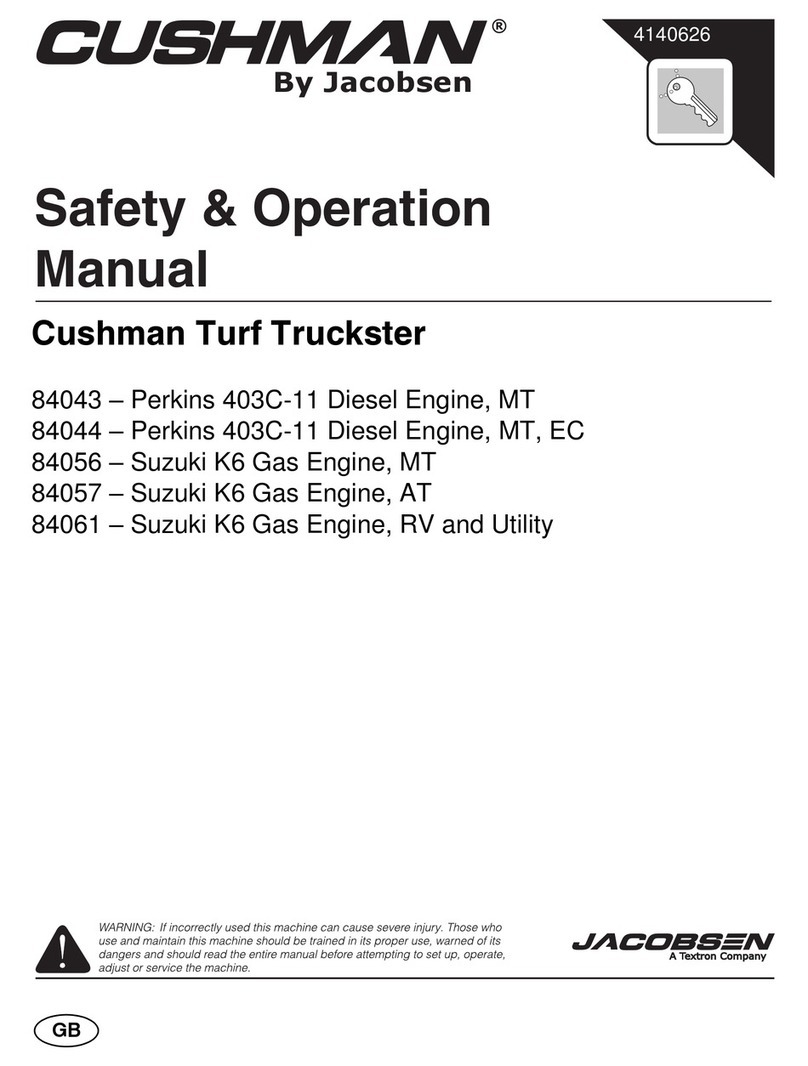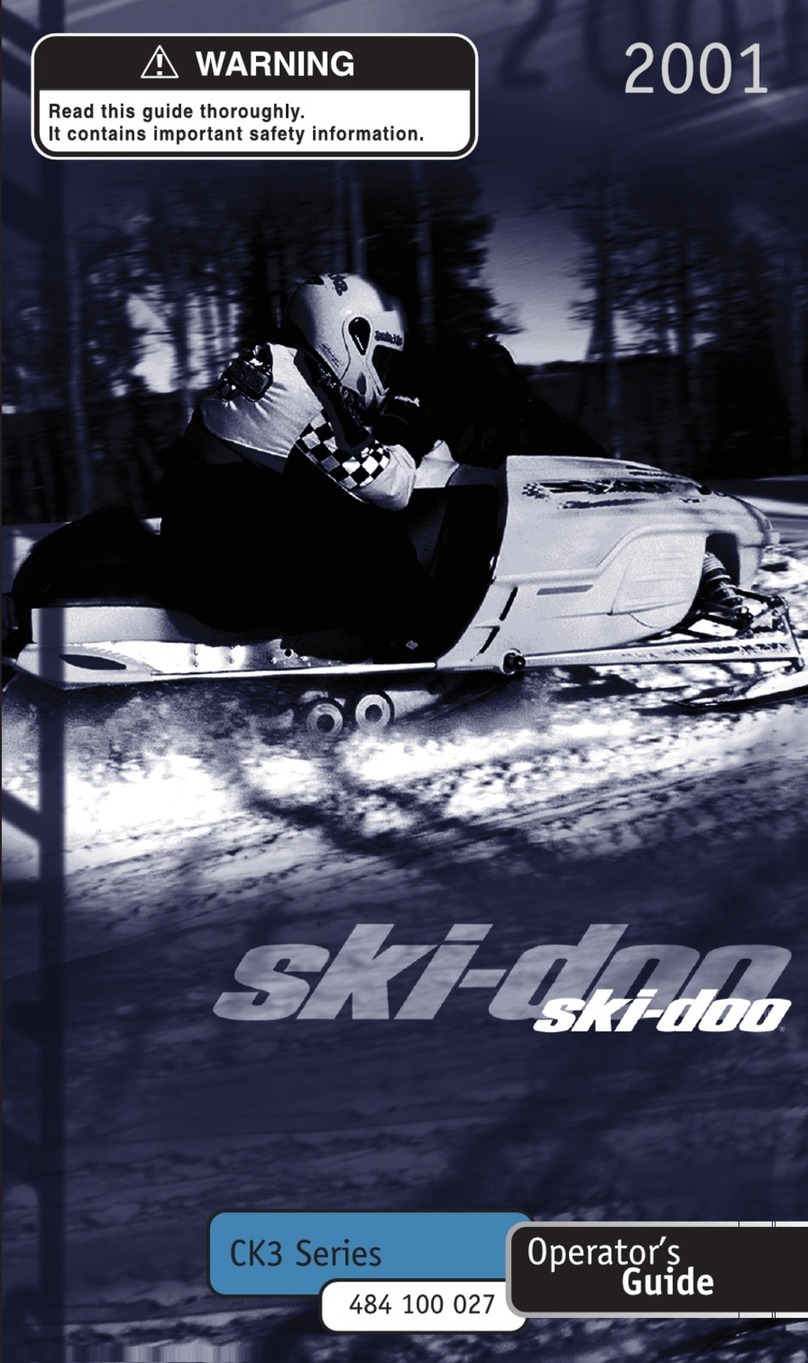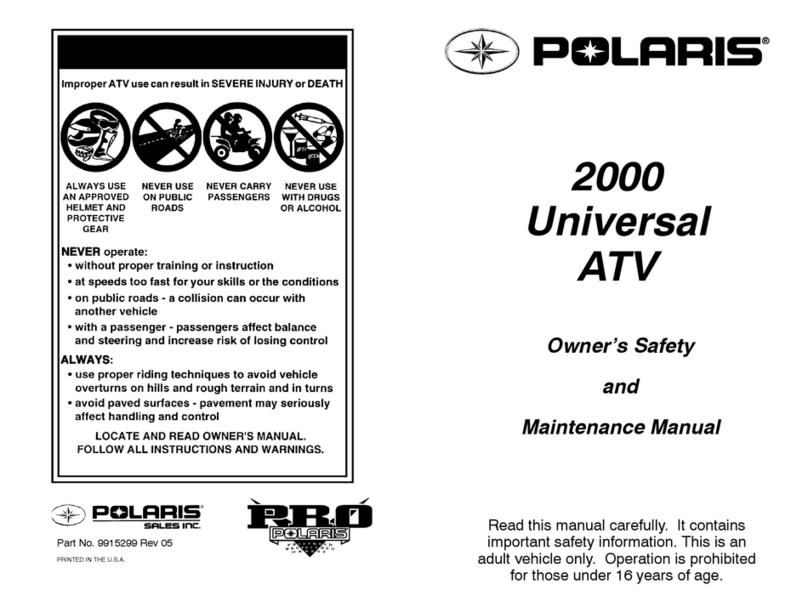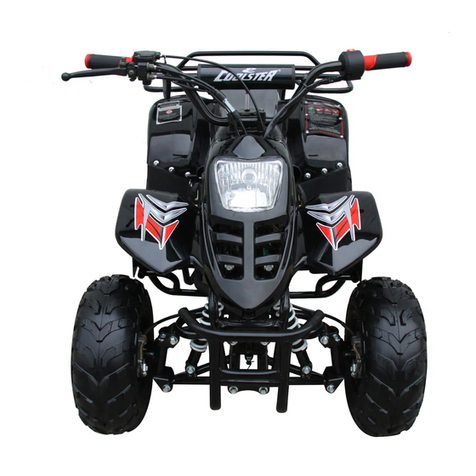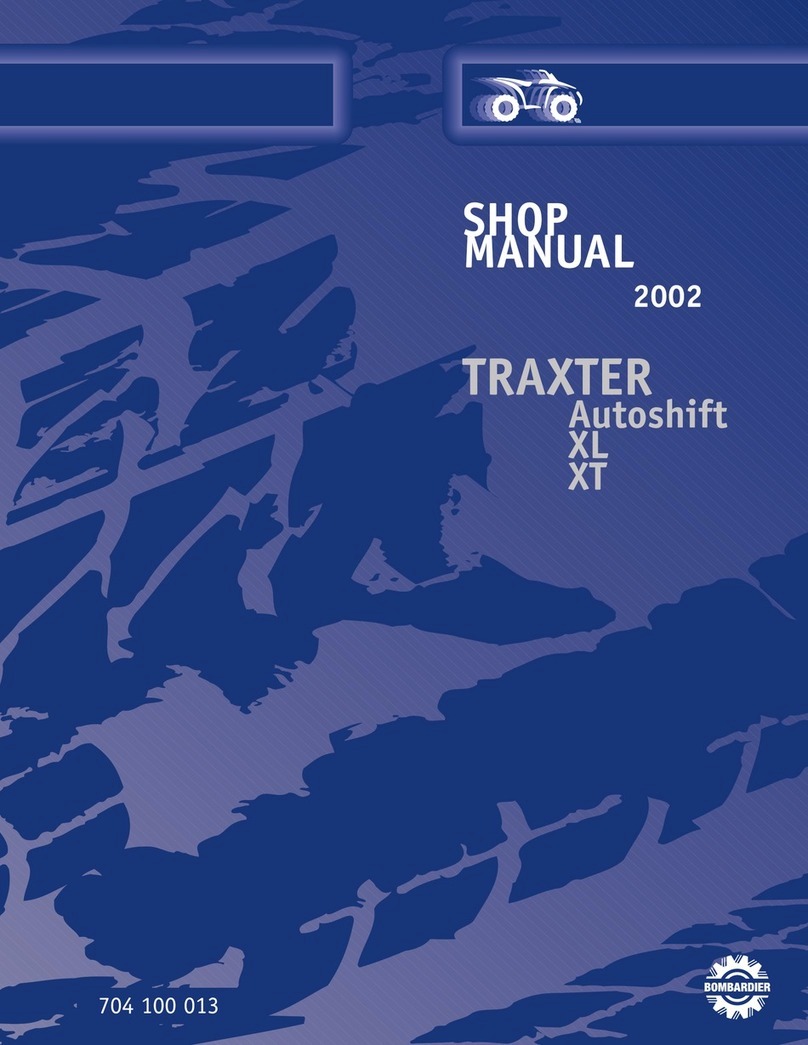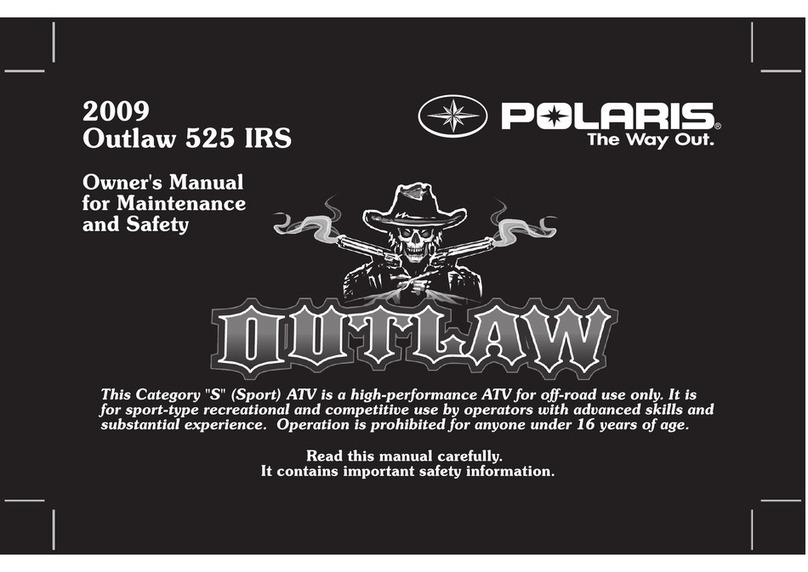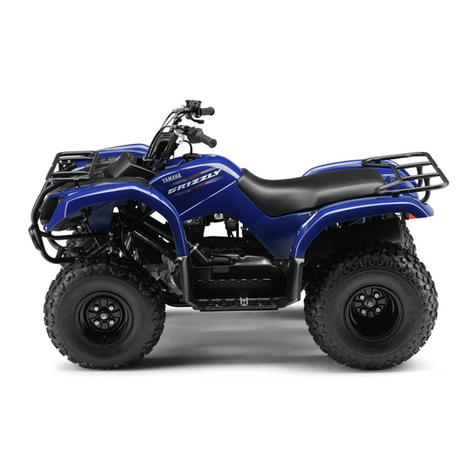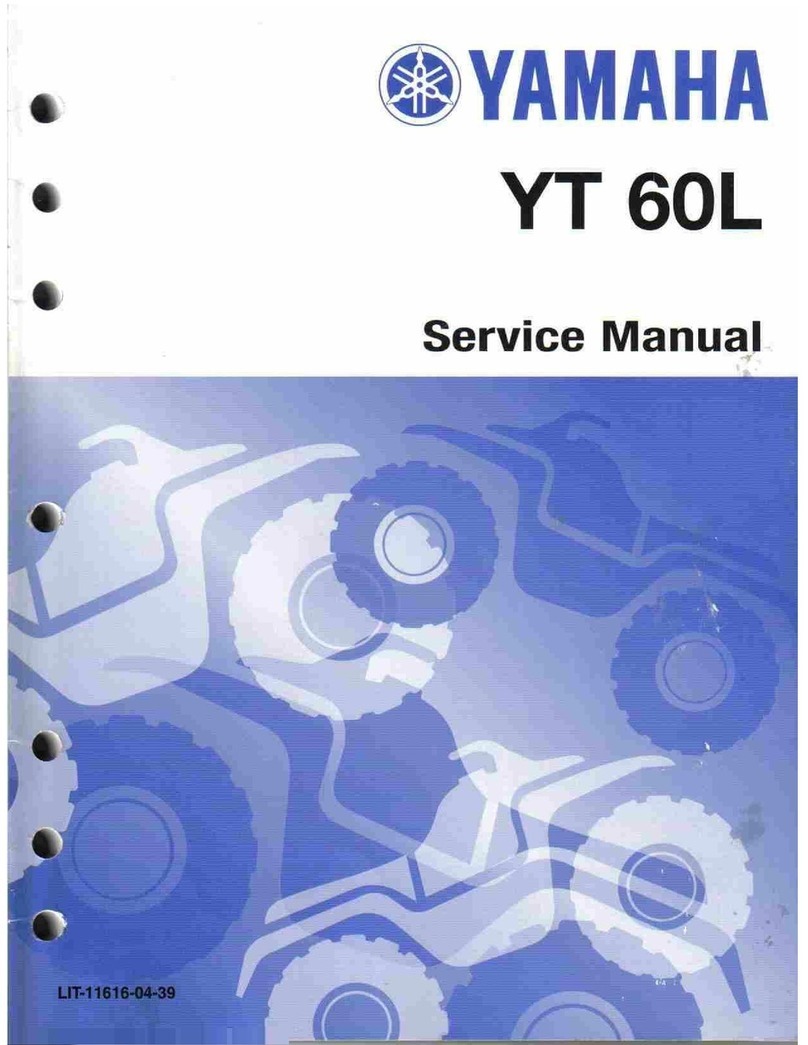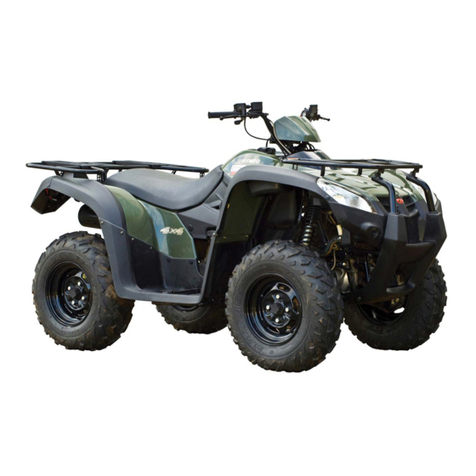Egimotors RZR Trail S 1000 User manual

Egimotors
Owner’s Manual
QUADRICYCLE
RZR Trail S 1000

WELCOME
Thank you for purchasing an Egimotors Quadricycle, and welcome to our
world-wide family of enthusiasts.
We have done This manual to inform you on how to use and maintain the
best condition of operation for your Quadricycle.
If after reading this manual, you still have some questions please do not
hesitate to contact your dealer that will be available to help you.
Be sure to visit us online at www.Egimotors.it for the latest news and for
product and Safety information.
We believe we sets a standard of excellence for all utility and Quadricycle
manufactured in the world today.
Many years of experience have gone into the engineering, design, and
development of your Quadricycle, making it the finest machine we’ve ever
produced.
For safe and enjoyable operation of your Quadricycle, be sure to follow the
instructions and recommendations in this owner’s manual.
Your manual contains instructions for the maintenance of the Quadricycle
and information about repairs.
Service Manual are available from Dealers, only them can perform major
repair and install accessory.
Your dealer knows your Quadricycle better than anyone and is interested in
your total satisfaction, he can perform your service needs during and after
the warranty period.
For the most up-to-date owner’s manual visit:
http://egimotors.it/libretto-uso-manutenzione/

WELCOME
3
4
Read and understand this Owner’s Manual is extremely important for your
safety and for all the operators, so please take your time to read all the
pages and be sure that is someone else will use the Quadricycle before will
take this manual and read and understand all, this will give you the best
knowledge and skills on how to ride in security.
Copyright 2023 Egimotors.
All the information contained within this publication is based on the latest
product information at the time of publication.
Due to constant improvement in the design and quality of product
components, some minor discrepancies may result between the actual unit
and the information presented in this publication.
Descriptions and or procedure in this publication are intended for reference
use only. No Liability can be accepted for omission or inaccuracies. Any
reprinting or reuse of the depictions and or procedures contained within this
publication are intended for reference use only. The original instruction is in
English.
Other languages are provided as translation of the original Instruction see
the Egimotors website for more details and procedure.

SAFETY
SYMBOLS
AND
SIGNAL
WORDS
4
The following signal words and symbols appear throughout this manual and on
your quadricycle. Your safety is involved when these words and symbols are
used. Become familiar with their meanings before reading the manual.
DANGER
DANGER indicates a hazardous situation which, if not avoided,WILL result in
death or serious injury.
WARNING
WARNING indicates a hazardous situation which,if not avoided,COULD result
in death or serious injury.
CAUTION
CAUTION indicatesa hazardous situation which, if not avoided,COULD result
in minor to moderate injury.
NOTICE
NOTICE provides key information by clarifyinginstructions.
IMPORTANT
IMPORTANT provides key reminders during disassembly, assembly, and
inspection of components.
The Prohibition Safety Sign indicates an action NOT to take in
order to avoid a hazard.
The MandatoryAction Sign indicatesan actionthat NEEDS to
be taken to avoid a hazard.

TABLEOFCONTENTS
5
Introduction...........................................................................
Safety......................................................................................
Features and Controls..........................................................
Operation...............................................................................
Emission
Control
Systems
...................................................
Maintenance ..........................................................................
Specifications........................................................................
Products.................................................................................
Troubleshooting....................................................................
Warranty.................................................................................
Maintenance
Log...................................................................
Certificate of Pre-Delivery …………………………………...


INTRODUCTION
7
INTRODUCTION
IMPORTANT
INFORMATION
WARNING
Failure to follow the warnings contained in this manual can resultin severe
injury or death.
This quadricycle is not a toy and can be hazardous tooperate. This quadricycle
handles differently than other quadricycles. A collision or rollover can occur
quickly, even during routine maneuvers, if you fail to take proper precautions.
•
Read this owner’s manual. Understand all safety warnings, precautions and
operating procedures before operating the quadricycle. Keep this manual
with the quadricycle at all times.
•
Thisquadricycle isan ADULTQUADRICYCLEONLY. YouMUST beat
least18 years of age and have a valid driver’s license to operate this
quadricycle.
•
No person under the age of 12 may ride as a passenger in this quadricycle.
•
Never permit a guest to operate this quadricycle unless the guest has read
this manual and all product labels.
•
Always keep hands, feet, and all other body parts inside the quadricycle
at all times.
•
Always wearthe properclothing when operatingorridingin this quadricycle.
All riders should wear substantial footwear, long pants, and a close-fitting
shirt. A hard hat or helmet and approved eye protection are recommended
when appropriate for riding or working conditions.
•
Never operate this quadricycle under the influence of drugs or alcohol, as
these conditions impair judgement and the operator’s ability to react.

INTRODUCTION
8
TOOLS FOR SAFE RIDING
To safely operate this quadricycle, itis importantto become familiar with its
features, controls, and characteristics. Review the Safety Briefings for this
quadricycle that apply to you:
•
Operators
•
Riders
•
Owners
•
Trailering the Quadricycle
•
Maintaining the Quadricycle
Additionally, read the product safety labelson the quadricycle and follow all rules and
regulations concerning the operation of this quadricycle in your area.

INTRODUCTION
9
NEAR-FIELD COMMUNICATION (NFC)
(IF EQUIPPED)
Some Egimotors quadricycles come equippedwith a near-field
communication (NFC) chip. The NFC chip is embedded in the Polaris
emblem located at the front of the quadricycle and seamlessly connects you
to a digital platform of quadricycle information and tools. See your dealer for
more information.
IMPORTANT
Not all devices are equipped with an NFC reader. Additionally, some devices
require third party applications toaccess NFC content. Forquestionsregarding
the NFC reader on your device, refer to the device’s user manual.
On models equipped with NFC, place your smartphone directly over the Polaris
emblem to do the following:
•
View quadricycle-
specific information
•
Access your Egimotors Garage
•
Downloadand viewthe
owner’s manual
•View
accessory
instructions
•
Watch how-to videos
•
Accesswarranty information
•
Check for service notifications
RIDE COMMAND WITH NFC
Additional NFC features are available whenusing the Ride Command mobile
app. To access these features, do the following:
1.
Download the Ride Command mobile app from the Apple App Store® or
Google Play® store.
2.
Create or log in to an existing account.
3.
From the Ride Command mobile app home screen, select Add Quadricycle.
4.
On the quadricycle, tap the NFC-enabled badge with the phone to
scan the quadricycle.
5.
Confirm information, name your quadricycle, and tap add to garage.
SYSTEM
REQUIREMENTS
Referto devicemanufacturer’s instructions to verify NFC readcapability, and/or
NFC-capable add-ons.

INTRODUCTION
10
QUADRICYCLE
IDENTIFICATION
NUMBERS
Record your quadricycle’s identification number q, engine serialnumber w, and
key number ein the spaces provided. Remove the spare key and store it in a
safe place. An ignition key can be duplicated only by ordering a EGIMOTORS
key blank (using your key number) and mating it with one of your existing keys.
The ignition switch must be replaced if all keys are lost.
1 Quadricycle
Identification
Number:
2 Engine Serial Number:
3 Key Number:

SAFETY
13
SAFETY
OWNER REQUIREMENTS
Improper use, maintenance, or modification of this quadricycle can lead to
serious injury or death.
Require proper use of your quadricycle. Do not
allow anyone to operate your quadricycle orride as a
passenger unless they are properly instructed and you
are sure they are willing to ride responsibly. To
prevent unauthorized use, always remove the ignition
key when the quadricycle is not in use.
Anymodifications orinstallation ofnon-EGIMOTORS-approvedaccessories
could increase the risk of injury. While you may find aftermarket products
similar in design and quality to EGIMOTORS accessories, recognize that some
aftermarket accessories or modifications are not suitable because of potential
safety hazards to you or others. It is never appropriate to install any additional
seating.
Check with the manufacturer to determine any potential effectofa modification
or accessory on the safe use of your quadricycle. You are responsible for
injuries related to modifications to the quadricycle. Modifications or
accessories may:
•
Damagemachine components - especiallymodificationsthat increasespeed
or power.
•
Make the quadricycle less stable at higher speeds.
•
Add weight, reducing the amount ofcargo and total weight youcan carry, and
raise the quadricycle’s center of gravity.
•
Overloadthe quadricycle’s electrical system capacity. Blowing a fuse may
cause a loss of lights or engine power.
•
Reducethe effectivenessof occupant protectionsystems, includingthe
seatbelts and the Rollover Protective Structure (ROPS).
•
Make it illegal to own or operate your quadricycle. EGIMOTORS-
authorized spark arresters, mufflers, and emissions control components
are mandatory for ownership or operation in many areas.
•
Void your warranty.
The quadricycle ROPS, when used with the seat belts and doors,
provides a structure to help protect occupants.The structurewill not protect
occupants in all rollovers or accidents.

SAFETY
14
DRIVER
AND
PASSENGER
QUALIFICATIONS
Make sure operators are 16 or olderwith a valid
driver’s license. Just because a teenager has a
license does not mean that they will make good
judgments about driving and avoid risk taking.
EGIMOTORSrecommends thatyou supervise younger
drivers. Set rules and put limits on how, when, and where
they are allowed to use this quadricycle. For example,
young drivers may need to have an adult in the quadricycle
with them and not be allowed to drive with their friends in
the quadricycle.
Make sure all riders fit the quadricycle. Be sure that the driver and all
passengers are able to:
•
sit with their backs against their seat,
•
adjust the seat belt to fit properly,
•
have both feet flat on the floor, and
•
have both hands on the steering wheel or ona passenger hand hold.
Do not allow children who need child safety seats or booster seats to ride
in the quadricycle. The quadricycle is not designed to restrain automotive
child safety seats.
Youare responsiblefor your passengers. Besure passengers are seated
properly, belted, holding the passenger hand hold, and ready to brace.
Unrestrained riders can fall out or be thrown around and from a moving quadricycle.
Every person must be properly seated and belted in their own seat. Two
people should never be belted into a single seat belt. People belted together can
crash into one another in a collision and be seriously injured. Never carry
passengers in the cargo bed as they could be thrown against or out of the
quadricycle or come into contact with moving parts.
Do not let people drive or ride after using alcohol or drugs.
18

SAFETY
15
PREPARE QUADRICYCLE FOR THE RIDE
Before starting off, always perform the Pre-Ride
Inspection. Failure to inspectand verify that the
quadricycle is in safe operating condition increases the
risk of an accident, which can lead to serious injury or
death.
ITEM
REMARK
Brake Fluid
Ensureproper leveland
condition
Frontand rear
suspension
Inspect,lubricate if
necessary
Steering
Ensure free operation
Tires
Inspectcondition and
pressure
Wheels/Lug
Nuts
Inspect, ensure
fastenertightness
Fuel and oil
Ensureproper levels
and condition
Coolant
Ensureproper leveland
condition
Indicator
lights/switches
Ensureproper
operation
Air Filter
Inspect,replace as
needed
Engine
intake
pre-filter
Inspect,clean
PVT
intake
pre-filter
Inspect,clean
Headlights
Checkoperation
Brake lights/taillights
Checkoperation
Seat Latches
Pushdown onboth seat
backs to ensure the
latches are secure

SAFETY
16
ITEM
REMARK
Seat Belts
Check length of belt for
damage, check latches
for proper operation
Exhaust
Inspectspark arrester
and clean if needed.
Quadricycle
Debris
Removegrass, leaves,
and other flammable
material or debris,
especially near the
exhaust system.
Passenger Hand Hold
Alwaysadjust thehand
hold to a comfortable
position for your
passenger before
operating. Make sure
the clasps are fully
locked after making
adjustments.
Lock adjustable
steering wheel
Do not adjust the
steeringwheel whilethe
quadricycle is moving.

SAFETY
17
Improper tire maintenance can lead to loss of control and an accident, which
could result in serious injury or death. To reduce your risk of injury:
•
Maintain EGIMOTORS recommended tire pressure. Check pressure before
operating. Even if your quadricycle has only been driven a short distance,
the tire pressure readings can become higher.
•
Make sure tire pressures match the specifications listed in the table below.
•
Only use the size and type of tires specified for this quadricycle.
•
Do not operate your quadricycle with worn or damaged tires.
•
Always follow your tire manufacturer’s instructions for maintenance.
MEASUREMENT
SPECIFICATION
Maximum Cargo Box Load
136 kg
Tire Pressure in kPa
Front: 69 kPa
Rear: 97 kPa
Maximum Weight Capacity
Includes weight of operator,
passenger, cargo, and accessories
336 kg

SAFETY
18
PREPARE YOURSELF, PASSENGERS, AND
CARGO FOR THE RIDE
Wear an approved helmet. Riding in this quadricycle without wearing an
approved helmet increases the risk of serious injury. For example, a helmet
reduces your risk of injury from head strikes with the quadricycle or other objects
even if there is no crash.
Approved helmets in the USA and Canadabear a U.S.
Department of Transportation (DOT) label. Approved
helmets in Europe, Asia, and Oceania bear the ECE
22.05 label. The ECE mark consists of a circle
surroundingthe letterE, followedby the distinguishing
number of the country which has granted approval.
The approval number and serial number will also be
displayed on the label.
Use shatterproof goggles or a shatterproof helmet face shield. Such
protective eyewear may reduce the risk of foreign materialgetting in your eyes
and help prevent loss of vision.
EGIMOTORSrecommends wearingapproved
Personal Protective Equipment (PPE) that have
markings indicating they are designed to standards
such as:
•
VESC 8
•V-
8
•
Z87.1
•
CE
Additional protective clothing and gear thatmay be appropriate for your
riding conditions includes:
•
Alwayswear shoes whenoperating. Consider wearingsturdy over-the-ankle
boots suitable for the terrain you will be riding in.
•
Full-finger gloves can protect against wind, sun, cold, and objects. Choose
gloves that fit snugly and allow fingers to move freely and grip on the steering
wheel or hand holds.
•
Consider long sleeves and long pants to help protect arms and legs.
•
Long-term exposure to wind and engine noisecan cause permanenthearing
loss. Properly worn hearing protective devices such as earplugs can help
prevent hearing loss. Check local laws or the rules of the riding area you are
in before wearing hearing protection to make sure its use is permitted.

SAFETY
19
Always stay completely inside the quadricycle and hold the steering
wheel or hand holds. Body parts outside of the quadricycle can be struck by
passing objects or crushed during a rollover. Do not put any part of your body
outside of the quadricycle for any reason. Do not hold onto the ROPS frame or
put any part of your body on the door.
Riding in this quadricycle without closed and latched cab doors increases the
riskof seriousinjuryordeathintheeventofanaccidentorrollover.Always make
sure all cab doors are closed and latched while riding in this quadricycle.
Be sure riders pay attention and plan ahead. If you think or feel the
quadricycle may tip or roll, reduce your risk of injury:
•
Keep a firm grip on the steering wheel or hand holds and brace yourself.
•
Do not put any part of your body outside of the quadricycle for any reason.
This quadricycle is not designed to carry unrestrained pets. An unrestrained
pet can be thrown about and injure riders, even during normal operation. When
transporting pets, use a pet crate suitable for off-road use that is secured to the
quadricycle.
Fuels such as gasoline can be extremely flammable. To reduce the risk of
serious injury or death, never carry fuel or other flammable liquids on this
quadricycle. Rollovers,crashes, rough riding,or changes in elevation or
temperature may lead to fuel spilling or vapor release from portable containers.
Hot quadricycle parts can cause fires, even after the engine has been turned
off.
Never exceed quadricycle weight capacities. Overloading the quadricycle or
carrying cargo improperly will cause changes in stability and handling, which could
cause loss of control or an accident. See the Specifications chapter for weight
capacities.
Secure cargo in the cargo box as far forward, centered and as low as
possible. When cargo cannot be positioned and secured in this way, operate
with extra caution. Unsecured cargo can strike and injure riders,affect
quadricycle handling, and result in loss of control.
The weight of riders and cargo changes quadricycle braking, handling, and
stability. To avoidloss ofcontrol,turn gradually,operate atslower speeds, and
avoid rougher or steeper terrain.

SAFETY
20
DRIVING
GUIDELINES
Driveresponsibly. This quadricycle is not a toy
and can be hazardous to operate. This
quadricycle has higher ground clearance and other
features to handle rugged terrain. It can be
overturned in situations where some other
quadricycles may not.
Abruptmaneuvers oraggressive driving,evenon
flat, open areas, can cause loss of control,
rollovers, severe injury or death. To avoid loss of
control and rollovers:
•
Avoidabrupt maneuvers, sideways sliding, skidding, orfishtailing, and never
do donuts.
•
Slow down before entering turn.
•
Avoid hard acceleration when turning, even from a stop.
High speed off-road operation
Driving off-road quadricycles to test the limits of your skills or abilities can be
very dangerous to you, passengers, and bystanders. Basic skills for driving a
car, ATV, or other off-road quadricycles do not equip drivers to safely attempt
high speed off-road operation. Develop your skill gradually through training,
practice, and experience with the various driving modes of this quadricycle and
the terrain in which you are operating. Always do a low speed reconnaissance
run (prerun) to become aware of anything you may encounter.
High speed off-road operation can lead to loss of control, crashes, or hard
landings that can seriously injure occupants (even without rollingthe quadricycle
or damaging it).
If you plan on using the quadricycle for high speed, off-roadcompetition,
additional safety equipment may be necessary. Check the rules that apply to
your competition.
Do not go over jumps —going airborne can lead to serious injury or death.
Going airborne can cause loss of control, rollovers, or crashing into the ground
and may damage the quadricycle. Even without crashing, landings can be hard
enough to cause any quadricycle suspension to fully compress (e.g., bottom
out).
Serious injuries, including spinal injuries, can occur even if ridersare properly
harnessed, wearing helmets and the quadricycle is not damaged and remains
upright.
You may encounter slopes, "jumps", or other terrainfeatures that could send the
quadricycle airborne, depending on your speed.These may bedefectively
designed, poorly maintained, or not suitable for this quadricycle. Slow down,
use extra care, and avoid going airborne. Never take this quadricycle over
jumps.

SAFETY
21
Watching someone else go over a jump or go airborne does not mean you can
safely do so. Egimotors cannot determine whether any jump youmay encounter
is appropriate for this quadricycle. Any jump, even a small one, could be
poorly maintained, designed, or not suitable for this quadricycle and may
cause serious injury or death.
Plan for hills, rough terrain, ruts, and other changes in traction and terrain.
Proceed slowly and with extra care on unfamiliar terrain. Avoid paved surfaces.
Sudden changes in terrain such as holes, depressions, banks, softer or harder
ground, or other irregularities may cause loss of control or rollover. Give yourself
time to react to rocks, bumps, or holes that may be hard to see. Operating in
deep snow or tall grass may make it harder to see obstacles.
If you cannot go around an obstacle, such as a fallen tree or a ditch, stop the
quadricycle in a safe place. Get out to inspect the area thoroughly. Look from
both your approach side and exit side. If you are reasonably confident you
can continue safely, choose the path that will allow you to go straight over
the obstacle to minimize the quadricycle tipping sideways. Go only fast
enough to maintain your momentum, but still give yourself plenty of time to
react to changes in conditions. If there is any question about your ability to
maneuver safely over the obstacle, you should turn around if the ground is
flat and you have the room, or back up until you find a less difficult path.
Abrupt application of the accelerator pedal can cause the tires to lose traction,
reducing control of the quadricycle and increasing the possibility of an
accident, especially while on sloped terrain or while crossing obstacles such
as rocks or logs.

SAFETY
22
Operating on Public Roads
If your Quadricycle is registered with a license plate as for public use road,
anyway, operating this Quadricycle on mayor public streets could result in a
collision with another vehicle.
Never operate this Quadricycle on highway see your locals law concerning the
category of your Quadricycle and where you can use it.
Quadricycles are allowed only on secondary road with a limited speed, respect
all the rules.
.
Improperly operating on hills can cause loss of control, rollover, or
accident, which can lead to serious injury or death. Use extra care when
operating on hills. Plan for rough terrain, ruts, and other changes in traction and
terrain.
Driving up hills
Check the terrain before ascending a hill and make sure it is not too slippery or
loose. Engage all-wheel drive for hills. Drive straight uphill, keeping speed and
throttle steady. Avoid steep hills which can cause the Quadricycle to overturn.
Recovering from stalling on a hill
If the Quadricycle loses forward speed, apply the brakes gradually and stop. Do
not attempt to turn the Quadricycle around. Instead, shift to reverse and allow the
Quadricycle to slowly roll straight downhill. Apply light brake pressure to control
speed.
Overtopping a hill
Slow down when you reach the crest of a hill. Never blindly go over the crest of a
hill or a drop off at high speed. An obstacle, a sharp drop, or another
Quadricycle or person could be on the other side of the hill.
Driving down hills
Check the terrain before descending a hill and make sure it is not too slippery or
loose. Engage all-wheel drive and proceed slowly, applying the brakes lightly.
Never descend a hill with the transmission in neutral or if the engine is turned off.
Avoidside hilling (riding across slopes)
If unavoidable, proceed slowly and with extra caution. Avoid obstacles and
changes in terrain that could cause the Quadricycle to tip or slide. If it feels like
the Quadricycle begins to tip or slide, immediately turn downhill.
Table of contents
Other Egimotors Offroad Vehicle manuals

Egimotors
Egimotors Sportsman Touring 1000 E 2023 User manual

Egimotors
Egimotors Sportsman Touring 570 E 2023 User manual
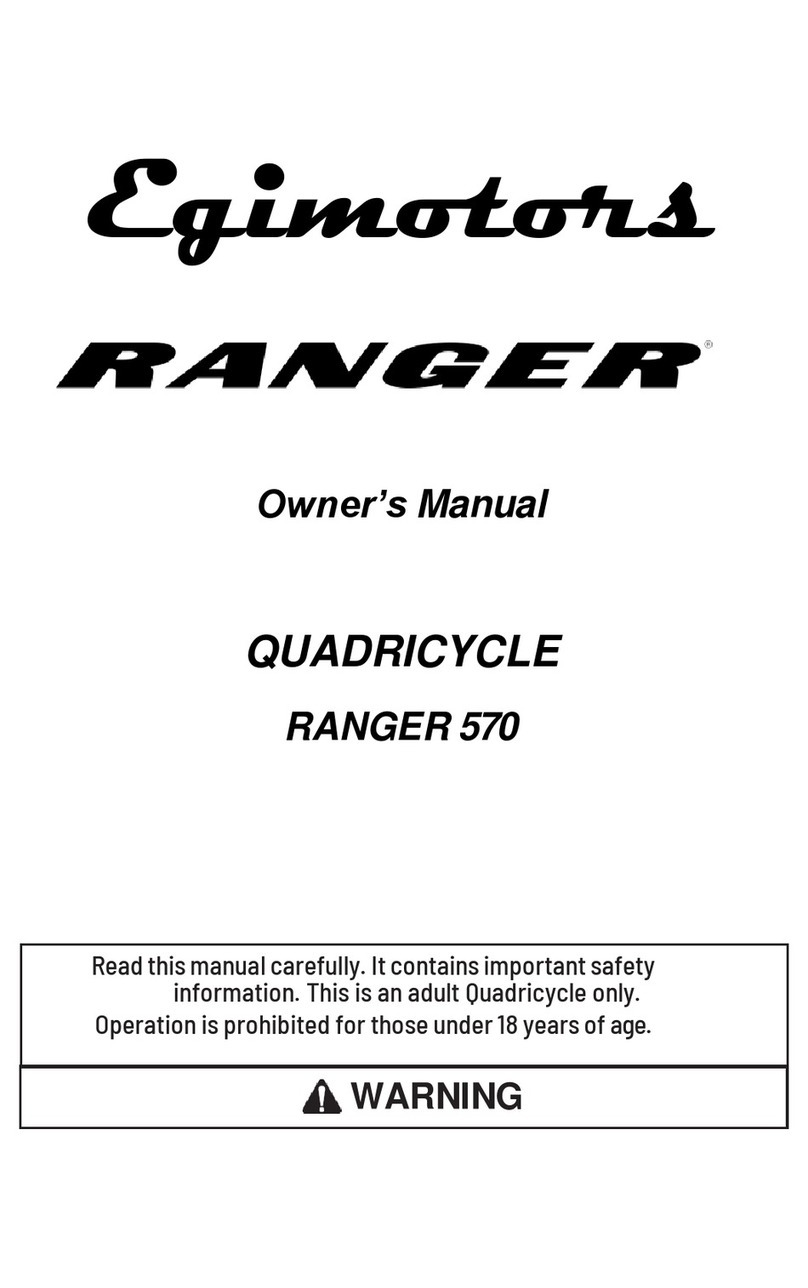
Egimotors
Egimotors RANGER 570 User manual

Egimotors
Egimotors Sportsman Touring 570 E 2023 User manual

Egimotors
Egimotors Sportsman 570 6x6 2023 User manual

Egimotors
Egimotors Sportsman XP 1000 E 2023 User manual

